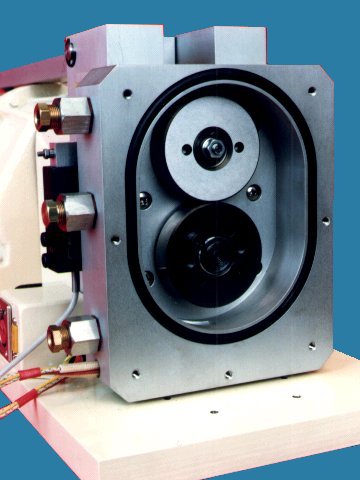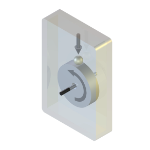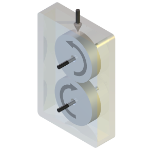-



Background
The TE 55 Lubricity Test Machine is a multi-function unit with adapters for ball on cylinder (BOCLE type) and cylinder on cylinder (TAFLE type) and crossed cylinder contact (Brugger and Reichert type) configurations. The control unit includes a SLIM 2000 Serial Link Interface Module and COMPEND 2000 Windows based control and data acquisition software. The main unit is based on the TE 53 Multi-Purpose Friction and Wear Tester. The machine may be used for evaluating both fuels and lubricants and any other general tribological tests involving sliding or sliding and rolling contacts, but does not aim to meet the requirements of any specified test standard.
Description
A bearing housing carries two parallel shafts. The lower shaft carries a flat profile ring or roller and is connected to an ac geared motor with frequency inverter variable speed drive.
In ball on cylinder configuration the upper shaft carries a holder for the fixed specimen and is restrained from rotating. In two roller configuration the upper shaft carries a roller and is driven from the lower shaft through a pair of gears. Seven fixed amounts of percentage slip are provided. The upper roller is mounted on a self-aligning bearing to achieve full width line contact between the specimens.
The TE 55 features a sealed chamber surrounding the test specimens and this allows for the continuous supply of conditioned test fluid into the contact zone, a vital part of controlling the conditions of the test or running with the contact fully immersed with test fluid. The enclosure incorporates a heater element to maintain the test fluid temperature.
The upper shaft is carried in a spherical bearing at one end that permits rotation about the gear contact line and has a floating bearing at the other end. This allow the shaft to pivot freely in the vertical and horizontal axes. Load is applied by dead weights through a 5:1 lever and acts on the front end of the shaft by pressing on the outer race of the floating bearing.
Horizontal movement in the direction perpendicular to the upper shaft axis and is resisted by a strain gauge transducer. This gives measurements of the tangential forces in the contact which are displayed as friction force on the control unit.
Control and Data Acquisition
The TE 55 has PC based sequence programmable control and data acquisition. This is provided by an integrated Serial Link Interface Module and COMPEND 2000 software running on a host PC, operating under Windows. Data is stored to hard disc in standard spread sheet compatible file formats (.csv or .tsv).
Tests are defined by a sequence of steps, each step containing set-point, data recording rates and alarm level information. Set-points may be adjusted by step change or ramp. The test sequence is followed unless interrupted by the operator or an alarm. Set-points may also be adjusted manually using on screen toggles.
-
Technical Specifications
Contact Geometry: Ball on Cylinder Cylinder on Cylinder Crossed Cylinder Speed Range: 30 to 850 rpm Equivalent Velocity: up to 4 m/s Slip Rate Gears: 1.79, 5.13, 8.70, 10.53, 13.33, 18.18 and 22.22% Friction Range: 130 N Load Range: 50 to 750 N Bath Temperature: ambient to 150°C Heater Power: 250 W Temperature Sensor: k-type thermocouple Cylinder Size: 60 mm diameter Sliding Specimen: 12.7 mm ball, roller or block Interface: Serial Link Interface Module Software: COMPEND 2000 Motor: 0.25 kW ac geared motor Controlled Parameters Rotational Speed Reservoir Temperature Test Duration Recorded Parameters Rotational Speed Friction Force Temperature Number of Revolutions Test Duration Sliding Speed Friction Coefficient Sliding Distance Services Electricity: 220/240V, single phase, 50 Hz, 1.2 kW 110/120 V, single phase, 60 Hz, 1.2 kW Installation Bench-mounting machine: 1,000 mm x 200 mm x 250 mm high, 50 kg Bench-mounting cabinet: 530 mm x 520 mm x 400 mm high , 25 kg Packing Specification: 0.48 m3, GW 165 kg, NW 105 kg -
Applications
ball on cylinder crossed cylinder multi-function sliding-rolling contact sliding-rolling line contact traction coefficient traction fluids -
Publications
Paper # 97 The Effect of Processing Route, Composition and Hardness on the Wear Response of Chromium Bearing Steels in a Rolling-Sliding Configuration Hanlon D N, Rainforth W M, Sellars C M, Wear 203-204, 1997, 220-229. Paper # 153 The Rolling/Sliding Wear Response of Conventionally Processed and Spray Formed High Chromium Content Cast Iron at Ambient and Elevated Temperature Hanlon D N, Rainforth W M, Sellars C M, Wear 225-229 (1999), 587-599. Paper # 157 Development and Use of ASTM Standards for Wear Testing Blau P J, Budinski K G, Wear 225-229 (1999), 1159-1170. Paper # 257 Tribological Properties of Electric Arc-Sprayed CuSn Coating for Bearing Elements M Toparli, E Celik, I Birlik, E Dokumaci Tribology Transactions, Volume 52, Issue 3 May 2009 , p. 389 – 394 Paper # 378 Wear Behaviour of Tool Steels with added (WTi)C Particles Leonard A J, Rainforth W M, Wear 255 (2003) 517 – 526 Paper # 384 The Rolling Sliding Wear Response of Conventionally Processed and Spray Formed High Speed Steel at Ambient and Elevated Temperature Hanlon D N, Rainforth W M, Wear 255 (2003) 956 – 966 Paper # 469 High resolution observations of friction-induced oxide and its interaction with the worn surface WM Rainforth, AJ Leonard, C Perrin, A Bedolla Tribology International Volume 35, Issue 11 , November 2002, p. 731-748 Paper # 486 Mechanical and tribological properties of electrolytic hard chrome and HVOF-sprayed coatings G Bolelli, V Cannillo, L Lusvarghi, S Riccò Surface and Coatings Technology Volume 200, Issue 9, 8 February 2006, p. 2995-3009 Paper # 546 The wear of wrought aluminium alloys under dry sliding conditions MJ Ghazali, WM Rainforth, H Jones Tribology International Volume 40, Issue 2, February 2007, p. 160-169 Paper # 547 Thermal aging effects on mechanical and tribological performance of PEEK and short fiber reinforced PEEK composites T Sinmazçelik, T Yilmaz Materials & Design Volume 28, Issue 2, 2007, p. 641-648 Paper # 570 Wear behavior of austempered ductile irons with dual matrix structures Y Sahin, M Erdogan, V Kilicli Materials Science and Engineering: A Volume 444, Issues 1-2, 25 January 2007, p. 31-38 Paper # 573 Wear behaviour of tool steels with added(WTi) C particles AJ Leonard, WM Rainforth Wear Volume 255, Number 1, August 2003, pp. 517-526 Paper # 575 Wear mechanisms of monolithic and multicomponent nitride coatings grown by combined arc etching and unbalanced magnetron sputtering Q Luo, WM Rainforth, WD Münz Surface and Coatings Technology Volumes 146-147, September-October 2001, p. 430-435 Paper # 607 The friction and wear of various hard-face claddings for deep-hole drilling J Truhan, R Menon, F LeClaire, J Wallin, J Qu, P Blau, Wear Volume 263, Issues 1-6, 10 September 2007, p. 234-239 Paper # 608 Experimental Study of the Smoothing Effect of a Ceramic Rolling Element on a Bearing Raceway in Contaminated Lubrication W Wang, PL Wong, F He, GTY Wan, Tribology Letters Volume 28, Number 1 / October, 2007 Paper # 609 A quantitative analysis of the influence of carbides size distributions on wear behaviour of high-speed steel in dry rolling/sliding contact C Rodenburg, WM Rainforth, Acta Materialia Volume 55, Issue 7, April 2007, p. 2443-2454 Paper # 642 Wear Mechanism of Glass Fiber Reinforced Epoxy Composites Under Dry Sliding Using Fuzzy Clustering Technique V Srinivasan, B Asaithambi, G Ganesan, R Karthikeyan, and K Palanikumar Journal of Reinforced Plastics and Composites 2008 Paper # 643 Plasma sprayed composite coatings obtained by liquid injection of secondary phases F Cipri, F Marra, G Pulci, J Tirillò, C Bartuli and T Valente Surface and Coatings Technology Volume 203, Issue 15, 25 May 2009, Pages 2116-2124 Paper # 644 Developing a mathematical model to evaluate wear rate of AA7075/SiCp powder metallurgy composites S Kumar and V Balasubramanian Wear Volume 264, Issues 11-12, 10 May 2008, p. 1026-1034 Paper # 698 Wear mechanisms experienced by a work roll grade high speed steel under different environmental conditions NF Garza-Montes-de-Oca, WM Rainforth Wear of Materials 2009 Paper # 742 A study of TiNiCr ternary shape memory alloys SF Hsieh, SL Chen, HC Lin, MH Lin Journal of Alloys and Compounds Volume 494, Issues 1-2, 2 April 2010, p. 155-160 Paper # 747 Comparative evaluation of dry sliding wear behaviour of plasma transferred arc hardfaced surfaces by the pin-on-roller method CS Ramachandran Proceedings of the Institution of Mechanical Engineers, Part J: Journal of Engineering Tribology Volume 224, Number 1 / 2010 p. 91-106 Paper # 748 Comparative study on the wear behavior of long and short glass fiber reinforced plastics V Srinivasan, R Karthikeyan, G Ganesan Metals and Materials International 2010 Volume 16, Number 2, 205-212 Paper # 750 Effect of contact load and lubricant volume on the properties of tribofilms formed under boundary lubrication in a fully formulated oil under extreme load conditions G Nehme, R Mourhatch Wear 2010 Volume 268, Issues 9-10, p. 1129-1147 Paper # 751 Effect of reinforcement size and volume fraction on the abrasive wear behaviour of AA7075 Al/SiCp P/M composites–A statistical analysis S Kumar Tribology International 2010 Volume 43, Issues 1-2, p. 414-422 Paper # 757 Erosion and wear behavior of nitrocarburized DC53 tool steel DC Wen Wear 2010 Volume 268, Issues 3-4, p. 629-636 Paper # 762 Friction and dry sliding wear behavior of carbon and glass fabric reinforced vinyl ester composites B Suresha, K Shiva Kumar, S Seetharamu Tribology International 2010 Volume 43, Issue 3, p. 602-609 Paper # 777 Effect of Different Surface Treatment Methods on the Friction and Effect of Different Surface Treatment Methods on the Friction and Wear Behavior of AISI 4140 Steel M Ulutan, ON Celik, H Gasan Journal of Materials Science & Technology 2010 Volume 26, Issue 3, p. 251-257 Paper # 794 Tribological behavior of a 20CrMo alloy implanted with nitrogen ions by plasma source ion implantation HB He, HY Li Wear 2010 Volume 268, Issues 3-4, p. 399-404 Paper # 802 Wear properties of DLC-coated steel rollers running with highly contaminated lubrication F He, PL Wong Tribology International 2010, Volume 43, Issues 5-6, p. 990-996 Paper # 810 Fluorinated FeF3 catalyst interactions in three different oil formulations using design of experiment optimization and chemistry characterization of tribofilms G Nehme Lubrication Science Volume 23, Issue 4, pages 153–179, June 2011 Paper # 811 Fluorinated mix in plain ZDDP oil and commercial oil using design of experiment analysis of all interactions and fundamental study of fluorinated mix in plain ZDDP oils under 2 different r/min test cycles and extreme boundary lubrication G Nehme Proceedings of the Institution of Mechanical Engineers, Part J: Journal of Engineering Tribology April 2011 vol. 225 no. 4 193-211 Paper # 812 Feasibility of utilizing response surface methodology for predicting wear of steels B Selçuk Proceedings of the Institution of Mechanical Engineers, Part J: Journal of Engineering Tribology May 2011 vol. 225 no. 5 277-287 Paper # 813 Material Science and Technology Division David P Stinton Technical Project Manager Quarterly Progress Report for April through June 2011 David P. Stinton Technical Project Manager Paper # 816 Optimization of Mechanism of Boundary Lubrication in Fully Formulated Commercial Engine Oil Using Design of Experiment GN Nehme Tribology Transactions Volume 54, Issue 2, 2011 Paper # 818 The Tribological Performance of Plain and Fully Formulated Commercial Engine Oil under 2 Different Rotational Speeds and Extreme Pressure Contact Using Design of Experiment GN Nehme Tribology Transactions Volume 54, Issue 4, 2011 Paper # 819 The Effect of FeF3/TiF3 catalysts on the thermal and tribological performance of plain oil ZDDP under extreme pressure loading G Nehme Wear – Accepted for Publication 2011 Paper # 820 Dry sliding wear behaviour of powder metallurgy Al-Mg-Si alloy-MoSi2 composites and the relationship with the microstructure J Corrochano, JC Walker, M Lieblich, J Ibáñez Wear Volume 270, Issues 9-10, 4 April 2011, Pages 658-665 Paper # 827 Interactions of fluorinated catalyst and polutetrafluoroethylene in two different plain zinc dialkyldithiophosphate oils and one fully formulated oil using design of Experiment G Nehme Lubrication Science Volume 23, Issue 4, pages 181–201, June 2011 Paper # 861 Effect of Extreme Load on Plain ZDDP Oil in the Presence of FeF3 Catalyst Using Design of Experiment and Fundamental Study under Two Different Rotational Speeds G Nehme Tribology Transactions Volume 55, Issue 6, 2012 Paper # 883 Tribological and Thermal Characteristics of Reduced phosphorus plain ZDDP oil in the Presence of PTFE/FeF3/TiF3 under Optimized Extreme Loading condition and a break in period using 2 different rotational speeds G Nehme Wear – Available online 3 December 2012 Paper # 890 Usability of Boron as an Alloying Element in Gray Cast Iron Rollers and its Effect to Abrasive Wear Behaviour C Meran, M Yuksel Advanced Materials Research (Volume 445) January 2012 Paper # 911 Analysis of fluorinated interactions in plain ZDDP and fully formulated oils using design of xperiment (DOE) and chemistry characterization of tribofilms in boundary lubrication under extreme loading conditions G Nehme Industrial Lubrication and Tribology, 2013 Paper # 912 Microstructure and Wear Behavior of Plasma-Sprayed Nanostructured WC–Co Coatings G Di Girolamo, F Marra, L Pilloni, G Pulci International Journal of Applied Ceramic Technology Volume 10, Issue 1, pages 60–71, January/February 2013 Paper # 913 Subsurface modifications in powder metallurgy aluminium alloy composites reinforced with intermetallic MoS2 particles under dry sliding wear M Lieblich, J Corrochano, J Ibáñez, V Vadillo Wear Volume 309, Issues 1–2, 15 January 2014, Pages 126–133 Paper # 997 Optimization of Extreme Load and Break-in Period in Plain ZDDP Oil with FeF3 Catalyst Using Design of Experiment and Fundamental Study under Different Speeds GN Nehme, M Dib Tribology Transactions, 2014, Taylor & Francis Paper # 1007 Wear modelling in rail–wheel contact Ramalho A Wear Volumes 330–331, May–June 2015, Pages 524–532 Paper # 1015 Effect of extreme contact load under two different rotational speeds on reduced phosphorus plain ZDDP oil in the presence of 1?per?cent FeF3 catalyst G Nehme Proc IMechE Part J: Engineering Tribology, August 2011; vol. 225, 8: pp. 833-844 Paper # 1019 Effects of Sliding Speed in a CuZn10 Brass Material on Wear M Bagci, H Imrek researchgate.net Paper # 1040 The effect of particle concentration in a magneto rheological suspension on the performance of a boundary lubricated contact W. C. Leung, W. A. Bullough, P. L. Wong and C Feng Proc IMechE Part J: Engineering Tribology, April 1, 2004; vol. 218, 4: pp. 251-264 Paper # 1189 Fretting wear comparison of cladding materials for reactor fuel cladding application TC Winter, RW Neu, PM Singh, LE Kolaya Journal of Nuclear Materials Volume 508, September 2018, Pages 505-515 -
User List
Launched 1995
Siebersdorf Research Centre Austria Euron S.p.A. Italy Tonen Japan Samchok National University Korea Ministry of University Affairs Thailand Liverpool John Moores University UK -
Download the Machine Leaflet

